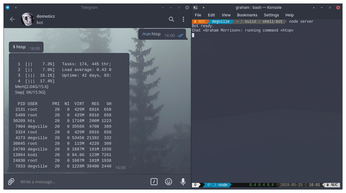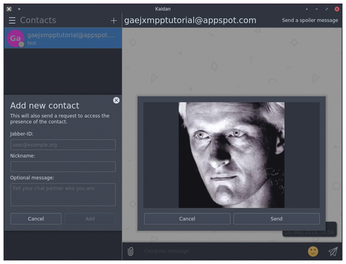Sparkling gems and new releases from the world of Free and Open Source Software
shell-bot
The Telegram messenger client has become hugely popular, partly thanks to its open source client and partly thanks to it not (currently) being owned by Facebook. For the security conscious, it's still a risky proposition without independent scrutiny of its server and encryption code, but it's undoubtedly useful. And one of the things that makes it more useful than the average messenger client is its "bot platform." This allows anyone patient enough to step through the lengthy and convoluted API key-generation process to run their own automated Telegram response system, feeding the contents of your own chats with whatever source you can push to the API.
Which is exactly what shell-bot does. With Telegram API access enabled and your own bot channel configured, you can install shell-bot on your Linux machine or server. This is relatively straightforward after you've worked through the few npm dependencies; the script configured itself when first executed. After that, it's as simple as leaving it running on the machine you wish to access. Shell-bot can then receive commands sent from your bot's Telegram channel after typing /run followed by the command. Command output is returned to the Telegram channel, and it updates "in-place," which means the output from a command like htop will update without scrolling. It's perfect for monitoring your system from wherever you can access a Telegram client. Type /help in the channel to see which other commands you can use. These include resize to change the output width, upload to download a file to your Telegram client from your Linux machine, control and meta for sending control and ALT shortcuts, and cancel to interrupt a running process. It works brilliantly and makes a great alternative to remembering a server's IP address and worrying whether you have your SSH keys or passphrase on you for remote administration.
Project Website
https://github.com/botgram/shell-bot
 Execute commands sent from a Telegram channel and see the results, without making any manual connection to a remote server.
Execute commands sent from a Telegram channel and see the results, without making any manual connection to a remote server.
Chat client
Kaidan
You could almost be forgiven for thinking the age of the open messaging client is over. WhatsApp and Telegram and countless other closed services seem to have taken over, and without some clever bridging, none of them can talk to each other. Matrix and Riot.im are promising modern open alternatives, but they don't have the critical mass to connect with people outside of your average open source community. However, even after being dumped by Google, some of the old protocols manage to survive. And Jabber and XMPP are perhaps the most prominent. All you really need is a modern, low resources, graphical client that connects to the Jabber/XMPP network and a few friends that feel the same way (or perhaps some of the many bots you can run). And that's exactly what this new KDE app, Kaidan, does.
With a name that's going to confuse lots of people with the video editor Kdenlive, Kaidan is a simple to use, quick, and functional Jabber client. You simply sign in, add a few contacts, and you're ready to go. Messages and your replies appear on the right while your contacts are listed on the left. The UI design is clean and minimal and looks very sleek thanks to the Qt components used to build the application. On a KDE desktop, it very much feels like a modern messaging client like Telegram or even Slack. The UI is adaptive, for example, which means it becomes just the conversation view when the window width is reduced, and you can easily see images you upload or within the conversation stream. This positions Kaiden brilliantly on both the desktop and any potential mobile platform that Plasma hopefully finds itself on in the future.
Project Website
Buy this article as PDF
(incl. VAT)
Buy Linux Magazine
Subscribe to our Linux Newsletters
Find Linux and Open Source Jobs
Subscribe to our ADMIN Newsletters
Support Our Work
Linux Magazine content is made possible with support from readers like you. Please consider contributing when you’ve found an article to be beneficial.

News
-
Linux Servers Targeted by Akira Ransomware
A group of bad actors who have already extorted $42 million have their sights set on the Linux platform.
-
TUXEDO Computers Unveils Linux Laptop Featuring AMD Ryzen CPU
This latest release is the first laptop to include the new CPU from Ryzen and Linux preinstalled.
-
XZ Gets the All-Clear
The back door xz vulnerability has been officially reverted for Fedora 40 and versions 38 and 39 were never affected.
-
Canonical Collaborates with Qualcomm on New Venture
This new joint effort is geared toward bringing Ubuntu and Ubuntu Core to Qualcomm-powered devices.
-
Kodi 21.0 Open-Source Entertainment Hub Released
After a year of development, the award-winning Kodi cross-platform, media center software is now available with many new additions and improvements.
-
Linux Usage Increases in Two Key Areas
If market share is your thing, you'll be happy to know that Linux is on the rise in two areas that, if they keep climbing, could have serious meaning for Linux's future.
-
Vulnerability Discovered in xz Libraries
An urgent alert for Fedora 40 has been posted and users should pay attention.
-
Canonical Bumps LTS Support to 12 years
If you're worried that your Ubuntu LTS release won't be supported long enough to last, Canonical has a surprise for you in the form of 12 years of security coverage.
-
Fedora 40 Beta Released Soon
With the official release of Fedora 40 coming in April, it's almost time to download the beta and see what's new.
-
New Pentesting Distribution to Compete with Kali Linux
SnoopGod is now available for your testing needs


